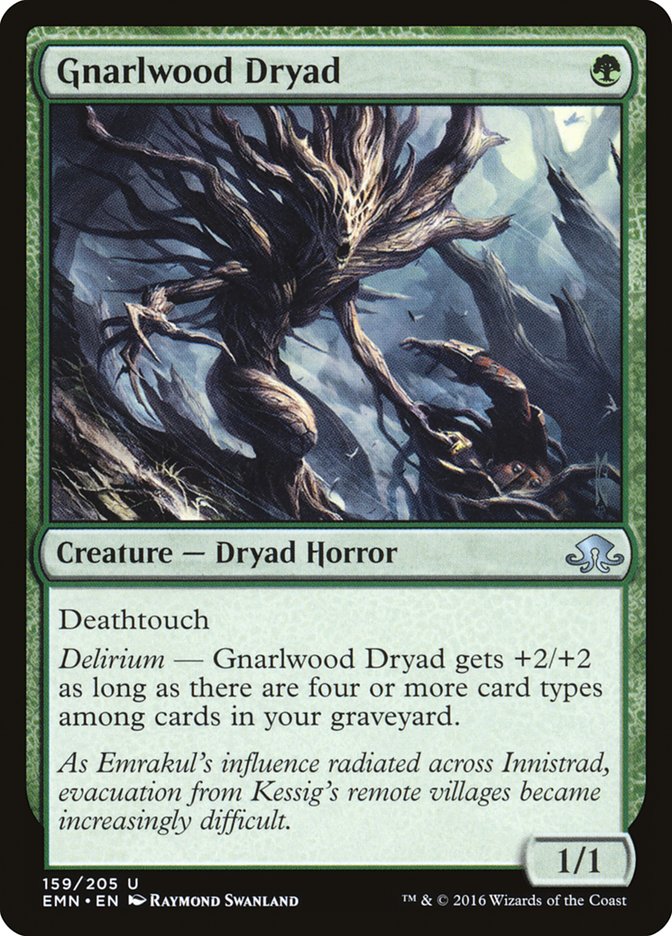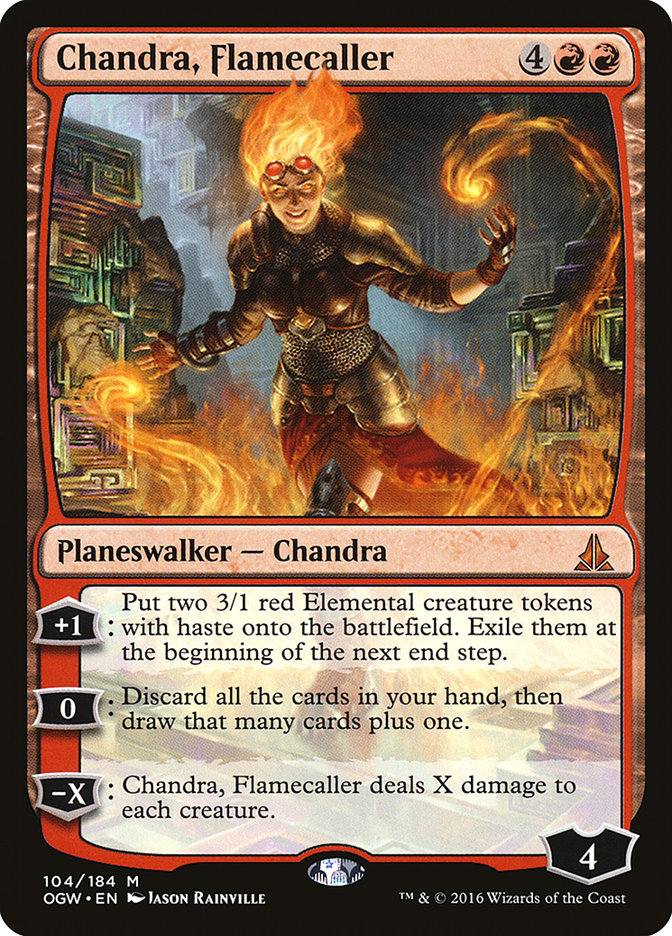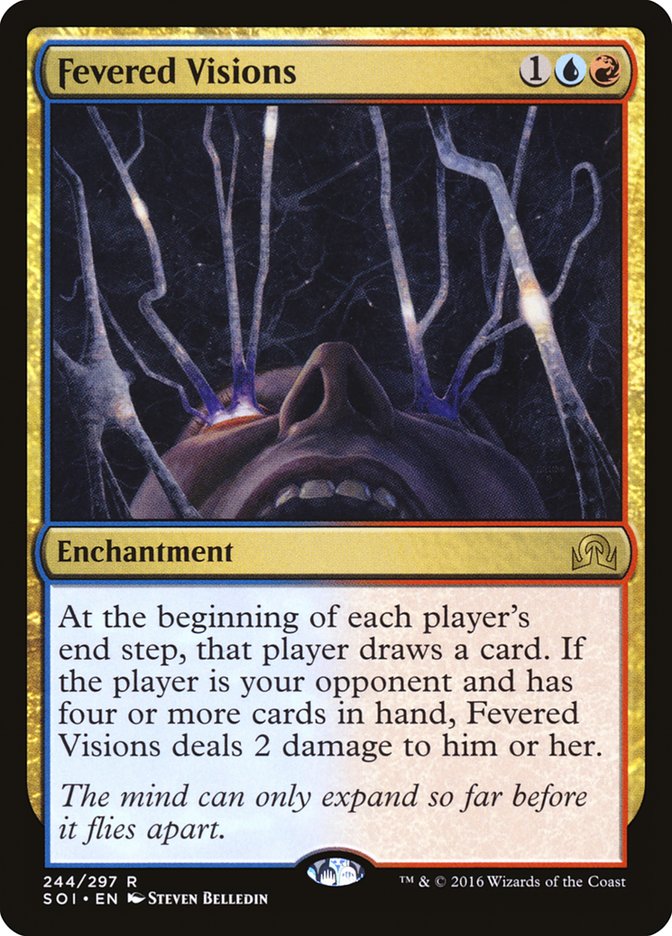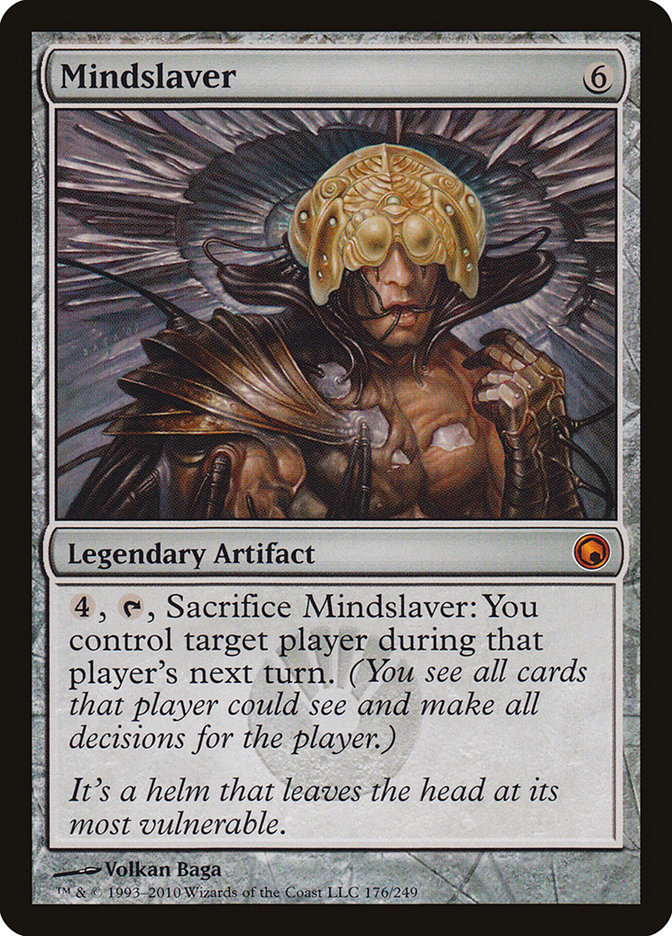It’s difficult to win when you get hit with an Emrakul, the Promised End.
My personal journey toward Emrakul starts with Michael Majors and the U/R Emerge deck. Soon after, Majors build a Temur version of the deck which blew us both away. He swore me to secrecy because he wanted to save it for the Pro Tour, and that decision seemed to have paid off for Andrew Brown and several of Majors’s Eureka teammates.
Creatures (24)
- 3 Shaman of Forgotten Ways
- 4 Jace, Vryn's Prodigy
- 1 Nissa, Vastwood Seer
- 4 Matter Reshaper
- 4 Wretched Gryff
- 3 Elder Deep-Fiend
- 1 Lashweed Lurker
- 4 Primal Druid
Lands (24)
Spells (12)

These are good Elder Deep-Fiend decks, but they aren’t good Emrakul, the Promised End decks. Right now, I think we’re seeing the decks like B/G Delirium that simply dabble in Emrakul are going to get crushed by their bigger counterparts. The creature-focused Temur Emerge decks at least have Elder Deep-Fiend and a quick clock to give them a better shot at defeating decks like Owen’s, but I think it’s an uphill battle.
When you see Elder Deep-Fiend, your first evaluation is likely something along the lines of, “If I can sacrifice a three-drop for value, then this becomes a good card.” For a while, I built around that narrative, but it’s wrong.
As Owen showed with his take on Temur Emerge, you don’t need much to make Elder Deep-Fiend good. Emerging off Ishkanah, Grafwidow is more than fine, as is hard-casting it for eight mana. Eureka’s deck functioned similarly, while Andrew Brown’s take on the deck mostly stayed true to the original plan.
Some of the “smaller” Temur Emerge decks were successful at #PTEMN, but I’m more interested in the builds that go hard on Emrakul, the Promised End. After all, by losing out on quick Elder Deep-Fiends, you’re not losing much.
These cards facilitate the engine around Emrakul, the Promised End. They either find lands to cast Emrakul, mill yourself to reduce its cost, or are unique card types themselves.
When trying to find a good Emrakul, the Promised End deck, I never focused on combining it with Kozilek’s Return, despite me working heavily on emerge-based Kozilek’s Return decks. I just missed it, likely because I assumed you would have to sweep the battlefield in order to buy time before you could cast Emrakul. That lead me to down a path toward Languish, but it was the wrong direction. Others did not miss that interaction, and it’s part of what makes Emrakul, the Promised End so good in this format.
Creatures (16)
- 3 Pilgrim's Eye
- 3 Emrakul, the Promised End
- 1 Wretched Gryff
- 4 Gnarlwood Dryad
- 3 Elder Deep-Fiend
- 2 Ishkanah, Grafwidow
Planeswalkers (1)
Lands (21)
Spells (22)

Owen’s deck looked so sweet that I decided to play it in #SCGRegionals, so I have some experience here. This deck maximizes the graveyard, focusing on putting multiple different types of cards in the graveyard to make Emrakul, the Promised End as cheap as possible. Each filtering card functions similarly to a Ponder (or Impulse, really), so you’re often doing a bunch of deck manipulation in order to find the card you need.
Nissa’s Pilgrimage is the Divination that keeps this deck functioning. Owen’s deck is land-light, but for good reason, and Nissa’s Pilgrimage helps you get to seven and eight mana, which is when you start dropping bombs. You often feel light on resources without a way to filter excess big creatures or Kozilek’s Returns out of your hand, but Nissa’s Pilgrimage smoothes you out.
With Vessel of Nascency, Corrupted Grafstone, Grapple with the Past, and Pilgrim’s Eye, being land-light makes a lot of sense. If you had more lands, you’d likely end up flooding out all too often, which isn’t what you want when you’re typically threat-light. Instead, use the various search cards to hit your land drops early and find your threats late.
Gather the Pack with Gnarlwood Dryad is a clever synergy that allows you to self-mill for profit while also having a cheap card to find with Gather the Pack that functions as a removal spell. With a plethora of two-mana plays, having something that costs one to fill the gaps in your curve is amazing, especially considering Gnarlwood Dryad does exactly what you need it to.
Having enough creatures in your deck to run Gather the Pack is one of the deckbuilding constraints, especially since most Emrakul, the Promised End / Kozilek’s Return decks want to be creature-light, but Gnarlwood Dryad is the perfect solution.
It’s worth noting that while Traverse the Ulvenwald is great in these Delirium decks, particularly the ones with low land counts, it’s quite bad with Grapple, Vessel, and Gather, often making it the odd card out. The other self-mill cards are equally bad with each other (as neither card can find the other), but Traverse is a payoff for self-mill, not an enabler. Typically, the creatures themselves are the payoffs. Most of the time you’d rather have additional copies of Emrakul, the Promised End in your deck, both to hit off Gather the Pack and to naturally draw. Tacking an additional mana onto Emrakul, the Promised End is the exact opposite of what these decks want to be doing.
There’s also no guarantee that you only need one Emrakul, the Promised End in your deck to win. Sometimes the first copy dies and you’d rather have additional copies in your deck to draw into rather than relying on something like Grapple with the Past to get it back. Traverse the Ulvenwald is phenomenal, and I’m sure we’ll see it popping up in more places, but I don’t want it in my Emrakul decks.
Casting the first Emrakul might get them, but you know what definitely gets them? Having access to the second copy.
The Chandra, Flamecaller, while seemingly difficult to cast and out of place, is likely the best planeswalker you could play in this deck for reducing Emrakul’s mana cost. When you spike that seventh card type, it makes casting Emrakul trivial, and therefore it’s worth playing. There are also times where you might be missing a card type like enchantment or artifact, and “planeswalker” serves as the wild card for whatever you’re missing. Without playing a planeswalker in the deck, you’d never have that opportunity. Playing a Chandra, Flamecaller is just good deckbuilding.
Going forward, the sideboard could be tuned. I’m also interested in lists with Jace, Vryn’s Prodigy and Primal Druid in the maindeck. I also feel like Corrupted Grafstone is likely worse than Hedron Archive, despite those two cards doing very different things. Having a card that can ramp bigger is nice, even if it doesn’t accelerate you to Ishkanah, Grafwidow.
What if we tried going ever harder than Owen’s deck though? It would probably look like one of these two decks.
Creatures (11)
Planeswalkers (2)
Lands (24)
Spells (23)

Creatures (13)
- 2 Dragonlord Atarka
- 1 Nissa, Vastwood Seer
- 2 World Breaker
- 1 Sylvan Advocate
- 2 Hedron Crawler
- 1 Ulvenwald Hydra
- 2 Emrakul, the Promised End
- 2 Ishkanah, Grafwidow
Lands (22)
Spells (25)

These G/R decks feel like the best of the bunch to come out of #PTEMN because they are the best at doing the turbo-Emrakul thing. Yukihiro’s deck is a tad on the slow side, and Reid’s deck can be clunky as well, but the ceiling is there.
The question comes down to “Elder Deep-Fiend or no?” and I’m actually leaning towards no. Most of what we want can be found in a nearly mono-green deck, so why bother? If you’re looking for something to bridge the gap between Gnarlwood Dryad, durdle, and Emrakul, the Promised End, you have Ishkanah, Grafwidow. Having additional monsters to trigger Kozilek’s Return is nice but probably unnecessary. Ken and Reid didn’t really need them.
Using all that information, I’ve been tweaking this deck and running it through Leagues on Magic Online:
Creatures (16)
- 2 Shaman of Forgotten Ways
- 2 Dragonlord Atarka
- 2 Hedron Crawler
- 3 Emrakul, the Promised End
- 4 Gnarlwood Dryad
- 3 Ishkanah, Grafwidow
Planeswalkers (2)
Lands (21)
- 13 Forest
- 4 Mountain
- 4 Game Trail
Spells (21)

The main difference in how this deck plays out compared to Owen’s deck is that it has more acceleration instead of Elder Deep-Fiends. The mid-boss, Dragonlord Atarka, smashes small creature decks similar to how Elder Deep-Fiend does (as long as it triggers a Kozilek’s Return), but it also has the benefit of delaying a Liliana, the Last Hope ultimate or taking out a threatening Gideon, Ally of Zendikar.
My sideboard is built to be able to cut Gnarlwood Dryads against control and combo while still having enough creatures for Gather the Pack, which is basically what Owen did. I could certainly have better creatures for those matchups, and I’ve tried things like Bedlam Reveler to some success, but ultimately I’d rather hedge a bit.
I’ve played around with the numbers for accelerants, and I’m satisfied with where I’m at but not ecstatic. Hedron Crawler is weak to Liliana, the Last Hope but is an artifact for delirium and a creature for Gather the Pack. Shaman of Forgotten Ways is a removal magnet but is huge in mirror matches where they likely won’t be able to remove it.
And that’s kind of the whole point.
Going forward, you’re going to want to have an edge in Emrakul mirrors. Either you want to interact directly with Emrakul, or you’re going to want to cast yours before your opponent has the chance to cast theirs.
Is U/R Fevered Visions a thing? If so, does it have the tools to beat up on these Emrakul, the Promised End decks consistently? If that’s the case, we might need some sideboard answers for Fevered Visions (World Breaker?) or a card like Pulse of Murasa to gain some life. Noose Constrictor is another nice option that lets you beat Fevered Visions.
Pulse of Murasa might be unnecessary, bad, or great; I haven’t decided yet. Noose Constrictor has been amazing, providing a huge clock and allowing you to ignore Fevered Visions by discarding cards. Even the hate decks are beatable if you try hard enough.
Instead of trying to go faster, we could try going slower. I wouldn’t be surprised if a black-based Emrakul, the Promised End deck had the best edge in the mirror either. Summary Dismissal is something the blue versions can play to gain an edge in the mirror, but is it really better than Transgress the Mind, Pick the Brain, or Infinite Obliteration?
Again, blue kind of has some neat tools here with counterspells and Coax from the Blind Eternities, but my money’s on the discard winning out over a large sample size.
I’m terrified of certain decks, like U/R Fevered Visions, showing up and making things difficult. As always, I’m trying to beat the popular decks while also anticipating change in the metagame.
This format feels like Pro Tour New Orleans, aka PT Tinker, where Mindslaver first debuted. Standard is obviously not as busted as Extended, but there’s a nice parallel here. Masashi Oiso was famously one of the seven (!) Tinker pilots in the Top 8, and he did it on very little testing. That much was apparent because he still played Phyrexian Processor in his Tinker deck, which didn’t line up well against his opponent’s Mindslavers.
Oiso lost more than a few games when he got Mindslavered and his opponents cast a Tinker, mostly to decimate his battlefield and look through his deck. They were delighted to find a copy of Phyrexian Processor, previously a staple of the archetype but a card that many people cut because of Mindslaver. Oiso didn’t test against many Mindslavers, so he wasn’t used to his opponents making him pay all his life.
With Emrakul, the Promised End rampaging all over the format, it’s important to consider the damage that can be done. For example, in Round 16 of #PTEMN, Reid Duke was constantly getting his manabase annihilated by his own Kozilek’s Returns and World Breakers. Without that happening, it’s possible he could have fired back an Emrakul of his own to at least remain on parity.
Maybe you shouldn’t alter your maindeck too much, but you should certainly be careful post-sideboard. For example, against black decks, I’ve greatly enjoyed making my opponent use Grasp of Darkness or Ruinous Path on their own creatures. I haven’t seen anyone get Emrakul-ed when they have a Noose Constrictor on the battlefield, but I’ve heard about it happening.
Transgress the Mind is the single card that I don’t think is cuttable that can be used against you, but it’s also a card you would have to topdeck on the Emrakul turn.
Emrakul, the Promised End is likely going to win the game the turn your opponent casts it, but you don’t have to make it easy for them.







